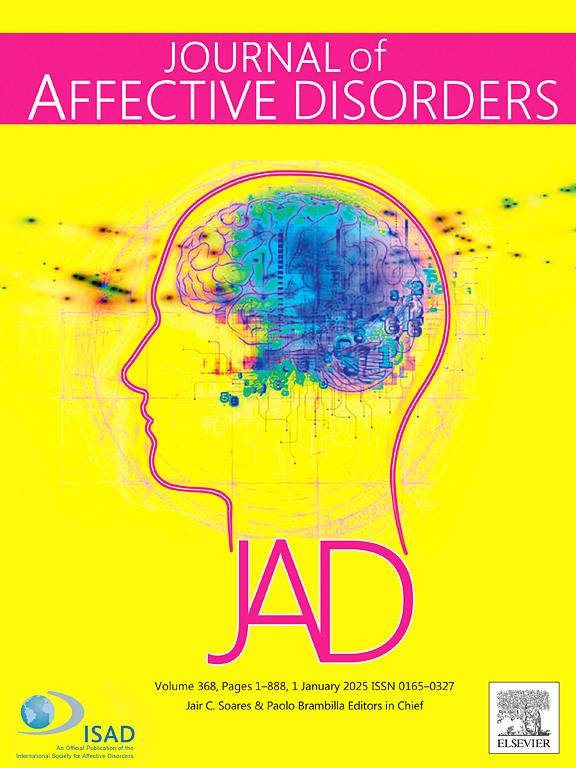双相情感障碍门诊患者的物质使用障碍和疼痛主诉
IF 4.9
2区 医学
Q1 CLINICAL NEUROLOGY
引用次数: 0
摘要
疼痛和物质使用障碍(sud)在双相情感障碍(BD)中很常见,但这些合并症之间的关系尚不清楚。我们的假设是:(1)痛觉性猝死的频率可能根据双相障碍患者的疼痛强度而变化;(2)双相障碍患者、疼痛和痛觉性猝死可能有特定的特征;(3)临床变量可以解释疼痛和痛觉性猝死之间的关联。方法我们纳入了终身诊断为BD I型或II型的FACE-BD队列门诊患者。目前的疼痛使用EQ-5D-5L量表中的一个项目分类为“无痛”、“轻度疼痛”、“中度疼痛”和“严重或极度疼痛”。采用双变量分析检验疼痛水平与其他变量之间的相关性,同时采用多元回归来表征双相障碍、疼痛和相关sud的个体特征。最后,进行通径分析以检验临床变量是否可以解释疼痛与相关sud之间的关联。结果在1897例BD参与者中,927例(48.9%)报告有疼痛。在sud患者中,较高的疼痛水平仅与终生酒精使用障碍(AUD)史相关。只有患有AUD和中度至极度疼痛的个体才有更大的终生焦虑障碍和恐慌障碍史的风险。在通径分析中,终生AUD与疼痛之间的关联部分由当前抑郁、焦虑和情感不稳定性水平介导。结论:我们的研究强调了BD患者报告的疼痛强度与终生AUD病史之间的多重关联。本文章由计算机程序翻译,如有差异,请以英文原文为准。
Substance use disorders in outpatients with bipolar disorder and pain complaints
Introduction
Pain and substance use disorders (SUDs) are common in bipolar disorder (BD), yet the associations between these comorbid conditions are poorly understood. Our hypotheses were: (1) the frequency of SUDs may vary according to pain intensity in individuals with BD, (2) individuals with BD, pain and SUDs may have specific characteristics, and (3) clinical variables could explain the associations between pain and SUDs.
Method
We included outpatients from the FACE-BD cohort with a lifetime diagnosis of BD type I or II. Current pain was categorized using one item of the EQ-5D-5L scale as “no pain”, “mild pain”, “moderate pain”, and “severe or extreme pain”. Associations between pain level and other variables were tested using bivariate analyses, while multiple regression was conducted to characterize individuals with BD, pain and relevant SUDs. Finally, path analysis was performed to examine whether clinical variables could explain the associations between pain and relevant SUDs.
Results
Among the 1897 BD participants, 927 reported any pain (48.9 %). Among SUDs, higher pain levels were only associated with a history of lifetime alcohol use disorder (AUD). Only individuals with both AUD and moderate to extreme pain had a greater risk of having a history of lifetime anxiety disorder and panic disorder. In path analysis, the association between lifetime AUD and pain was partly mediated by current levels of depression, anxiety, and affective lability.
Conclusion
Our study highlights multiple associations in individuals with BD between the intensity of reported pain and history of lifetime AUD.
求助全文
通过发布文献求助,成功后即可免费获取论文全文。
去求助
来源期刊

Journal of affective disorders
医学-精神病学
CiteScore
10.90
自引率
6.10%
发文量
1319
审稿时长
9.3 weeks
期刊介绍:
The Journal of Affective Disorders publishes papers concerned with affective disorders in the widest sense: depression, mania, mood spectrum, emotions and personality, anxiety and stress. It is interdisciplinary and aims to bring together different approaches for a diverse readership. Top quality papers will be accepted dealing with any aspect of affective disorders, including neuroimaging, cognitive neurosciences, genetics, molecular biology, experimental and clinical neurosciences, pharmacology, neuroimmunoendocrinology, intervention and treatment trials.
 求助内容:
求助内容: 应助结果提醒方式:
应助结果提醒方式:


